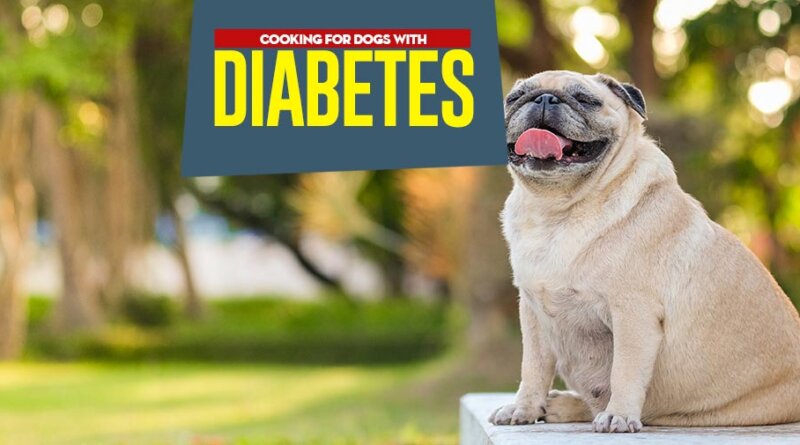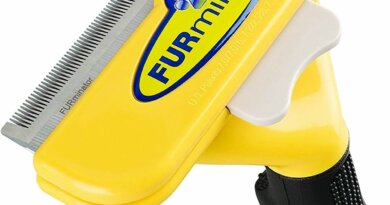Science-based Guide on What to Feed a Diabetic Dog
Diagnosis of diabetes in dogs is more common today than ever before (1). It’s been estimated that about 1 in 100 dogs will develop diabetes mellitus by time they’re 12 years old. Female dogs and some breeds are more susceptible to diabetes than others (2).
Caring for a dog with diabetes can be stressful, expensive and time-consuming for pet owners, but with the right dog diabetes diet, it’s possible to manage the condition. So how and what to feed a diabetic dog, and what not to feed a diabetic dog?
Based on a meta-review of most recent studies, the three most effective solutions for dealing with diabetes in dogs and structuring a diabetic dog diet are: (a) high fiber, (b) medium-carb, high/medium-protein, and (c) caloric restriction (3, 4, 5, 6). This, paired with daily exercise regime, will bring about positive results.
Note: It’s beyond the scope of this article to delve deep into what diabetes in dogs. Instead, the article will focus on what to feed a diabetic dog, and how to reverse the symptoms with the proper diabetic dog diet. For more general information on diabetes mellitus in dogs, please refer to Merck Vet Manual.
What is Diabetes in Dogs?
Diabetes mellitus, or simply diabetes in dogs, is a chronic metabolic disorder that occurs when the dog’s body cannot utilize glucose the way it’s supposed to (7). The dog’s pancreas is unable to produce enough insulin to turn food into energy, or the cells in a body are failing to use insulin properly. The first stage is known as type 1 diabetes in humans, and that is the only type of diabetes that affects dogs (8).
Timely diagnosis of diabetes in dogs is crucial for successful management. If you notice that your dog is displaying excessive thirst or increased urination, which are just some of the symptoms of diabetes, take him to the vet. Your vet will help you develop a diabetic dog diet plan and explain what to feed a diabetic dog to alleviate the symptoms.
Even though the exact cause of dog diabetes is unknown, some factors that might lead to diabetes in dogs include genetics, autoimmune disease, obesity and chronic pancreatitis (9, 10). Female dogs are at greater risk at later stages in life. Some breeds are more at risk of diabetes as well, like Australian Terriers, Schnauzers, Poodles and Dachshunds (11).
So what to feed a diabetic dog to reverse the condition? Unfortunately, diabetes in dogs cannot be cured. However, studies found that with proper management and a well-designed diabetic dog diet, pets can still have a normal and healthy life (12, 13, 14).
RELATED: 25 Ways to Manage Diabetes in Dogs [Infographic]
The Basics of Dog Diabetes Diet
Your vet should always be the first point of contact, because dogs with diabetes will require a daily shot of insulin to help them regulate their blood glucose levels. Your vet will also explain what not to feed a diabetic dog and how to structure a diabetic dog diet as part of the management plan. Here’s everything you must know about this diet.
Dietary Guidelines
Dogs with diabetes must stay in shape. Make sure that your pet doesn’t get overweight, and if he already is, it is crucial that he loses those extra pounds because that will improve his condition and help his cells to use insulin better. This should be achieved through a combination of daily exercise and caloric restriction (15, 16).
Either you or your vet can determine the exact number of calories your dog will require daily based on his activity level, age and current weight. Timing of meals is also significant. In most cases, feeding your dog 2-3 times a day, at the exact same time, is optimal (17). Your dog’s diet must be consistent in the amount of carbs and the ratio of protein/fat/carbs; otherwise, it may can cause dramatic changes in glucose levels.
Commercial dog foods for diabetes will be fine in most cases (18, 19, 20). Prescription dog foods purchased at veterinary clinics can be very costly, but fortunately, many over-the-counter brands have similar or even identical caloric and macronutrient composition and are much cheaper. Too, you can prepare homemade diabetic dog foods at home.
It’s crucial that your dog eats regularly because of his insulin shots. If he isn’t eating much, he might not like the food or there could be a health related reason. It can even be a sign of complications related to diabetes. You can always try to entice your dog to eat: try mixing a tablespoon of canned dog food with his regular meals, using low-carb low calorie dog food mixers, or adding some bone broth to your dog’s dry foods.
Studies are still unclear on the exact best nutrient profile and what to feed a diabetic dog. However, based on current evidence, veterinarians recommend a low-fat, low/medium-carbohydrate, high/medium-protein, high-fiber diabetic diet for dogs (21, 22, 23, 24, 25, 26). This diet helps your dog stay fit and slows the glucose from entering the bloodstream.
Finally, ensure that your dog drinks a lot of water when on a high fiber diet.
Important Nutrients
Since there is no one recommended dog diabetes diet that suits all pets with diabetes mellitus, the amount of fiber or carbs will depend on many factors, particularly on the weight and exercise regime of your dog. Here’s what to feed a diabetic dog in terms of macronutrients that will help manage the condition.
Protein
As with majority of other conditions, high-quality protein sources are one of the crucial factors for making homemade diabetic dog food meals or picking commercial dog food for diabetes. Things like beef, chicken, turkey and fish are great protein sources. Go for low-fat recipes, including meats that are lean: red meats or chicken breasts, for example.
L-Carnitine, which is an essential amino acid found in meat sources like beef and lamb, can be of great help in controlling diabetes in dogs. It can improve fat metabolism, protect muscles and help in maintaining lean body mass. It’s best that dogs receive it through a wholesome diet rather than a supplement for effective absorption.
Carbohydrates
Carbs are responsible for biggest changes in blood sugar levels after eating because they are digested faster than fats and proteins, and they cause blood sugar spikes. Consuming carbs is directly related to timing of your dog’s meals and his insulin dosage.
The source and type of carbs is not as important (because most of them will cause blood glucose spikes anyway) as the timing and amount of carbs in the diabetic dog diet. That said, simple carbs with high glycemic index (GI) should be avoided because they cause rapid glucose spikes; stick to wholesome foods and carbs with low GI.
When structuring diabetic diet for dogs, it’s essential to pay attention to glycemic index of foods – it can help you determine the effects of carbs on blood sugar levels, and estimate how much every gram of carbs (minus fiber) in certain food raises your dog’s blood sugar levels after consumption. There are comprehensive glycemic index charts you can consult at any time.
Low-glycemic foods will cause glucose release in the dog’s body in a steady and slow flow. High-glycemic foods will cause a more rapid increase in blood glucose levels.
Some of the low-glycemic foods you can include in homemade diabetic dog food meals are whole grains, legumes, most vegetables and fruits. Foods with average glycemic index are brown rice, potatoes, sweet potatoes, and honey. High-glycemic foods include white bread, white rice and most unhealthy high carb foods you shouldn’t feed a dog anyway.
Fiber
Currently, scientific evidence shows that fiber may be the most important factor in a diabetic dog diet. Fiber can be found in many fruits and most vegetables; it will also help with digestion of foods. Fiber slows down gastric emptying, as well as the digestion of carbs, which in turn slows down the release of glucose and prevents rapid spikes of blood sugar levels. In most cases, moderate amounts of fiber are enough for dogs with diabetes.
Fats
When it comes to fats, the safest bet is to feed your diabetic dog to a low-fat diet, based on most recent research. Choose foods that are high in omega-3 fatty acids or add some fish oil supplements into your homemade diabetic dog food meals, because they can help in decreasing blood lipid levels and inflammation, and they can also help in regulation of the immune system. Fish and fish oils are the best sources of these acids.
Structuring a Diet for Diabetic Dogs
Structuring a dog diabetes diet is not easy at first, but there are some general rules you can adhere to. Once you get used to using the exact same foods, know what to feed a diabetic dog and what not to feed a diabetic dog, and are used to timing, it becomes a routine and shouldn’t feel like a hassle as it does at the very beginning.
What to Feed a Diabetic Dog
Include high-quality protein from lean meats and fish in your dog’s diet. Lamb, beef, chicken, turkey and many types of fish are all good sources of protein. You can also add eggs to your pet’s diet and some dairy products, like low-fat cottage cheese.
Some fruits and berries are good in very small amounts because they contain a large number of antioxidants and some fiber. However, they are high in natural sugars (and high GI) and will spike glucose levels, so use moderation.
To keep your dog’s gut flora in good shape, adding some plain yogurt as part of your diabetic dog’s regular diet can help with digestion and nutrient absorption. Alternatively to yogurt or other probiotic foods, you can also use probiotic supplements which have higher concentration of good bacteria and are likely to provide better results that yogurt.
Green leafy vegetables are ideal for dogs with diabetes because they are high in fiber and low in fat and calories. Vegetables like broccoli, celery, kale, asparagus can be included in a diabetic dog diet. Carrots and sweet potatoes are also good for your dog’s digestion, but only in moderation since they contain higher amounts of sugars (high GI).
Some recommend adding grapefruit juice to a diabetic dog diet because it may help with weight control, but there’s little evidence to that. You can add a little bit of it to your dog’s water or mix it with a meal. Same with cinnamon which may or may not serve as a substitute for insulin in the blood. Sprinkle a very small amount on your dog’s meal.
Treats between meals are fine if they are very low in sugar and carbs. Commercial snacks with syrup, fructose, maltose, or dextrose on the ingredients label should be avoided. Good healthy dog treats for diabetic dogs are homemade dehydrated meats (recipe). Canned pumpkin can also be a good option, just keep it at moderate to low levels.
What Not to Feed a Diabetic Dog
Most human foods and table scraps, like junk food and baked good should be completely avoided because most of them are high in sugar and high GI carbs. If you want to give your dog some baked products, do it yourself. Homemade diabetic dog treats can be fine if they are not made of foods with high glycemic index.
If you normally allow your dog to snack on human foods, remember that things like cereal, white bread, crackers and so forth must be avoided because they will cause spikes in blood sugar levels. Avoid corn and anything made of corn as well. White rice should also be avoided or at least limited. Brown rice might be a little better because it’s lower on the GI scale but it’s still relatively high.
Most canned foods can be either bad or average, depending on the type. That’s because canned dog food usually contains higher amount of carbs than dry kibble, thus it’s best to avoid it altogether on a dog diabetes diet. Especially avoid canned products that are full of things like corn gluten, corn, wheat gluten.
Homemade Diabetic Dog Food Meals
Commercial dog foods for diabetes may be more convenient, but if choosing prescription diets, they can also be very costly. As long as you discuss this with your vet, understand what to feed a diabetic dog and what not to feed a diabetic dog, you may be able to structure a good diabetic diet for dogs by cooking yourself.
Homemade diabetic dog food recipes (like this one, this one or this one) should follow the above mentioned guidelines on macronutrients and specific foods. There are more recipes for dogs with diabetes out there (including our 25 Vet Recommended Recipes book), but here’s one example of a good diabetic homemade dog food recipe you can start with.
Basic Diabetic Homemade Dog Food Recipe
This recipe is good because it’s low in fat and has a lot of green, leafy vegetables.
Ingredients
- 6 pounds of lean beef
- 1 broccoli, fresh
- 1 package of fresh spinach (10 oz.)
- 2 cups of chopped celery
- 3 cups of rye
- 4 cups of brown rice
- 165 oz. of liquid (1/2 broth and 1/2 water)
Preparation
Simmer the lean beef in the liquid for 20-30 minutes and then remove it. Mix all other ingredients in a pot and put it on a stove until liquid is absorbed. Mix the beef and vegetables and put the hot rice and rye over the mix, then mix it all together.
You can keep all leftovers in your fridge in an airtight container. You can also use any other protein source instead of beef, like chicken or turkey, and you can also use any other green vegetables.
The Best Dog Food for Diabetic Dogs
Other than homemade dog food for diabetic dogs and prescription food brands, there are a few often vet recommended diabetic dog food brands available over the counter. These foods contain a similar ratio of protein/fat/carbs/fiber to those more expensive brands sold in veterinary clinics. Below are a few brands you can discuss with your vet.
READ NEXT: 15 Tips on Diabetic Dog Food and How to Feed Dogs with Diabetes






